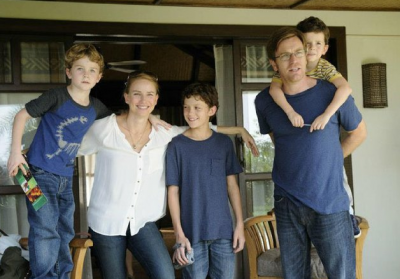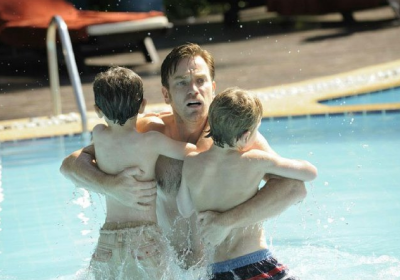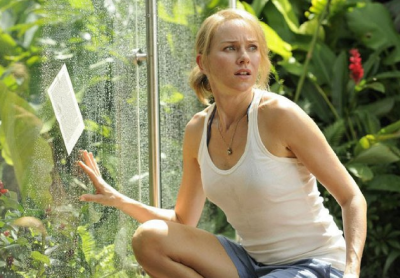You’ve never quite seen anything like the tsunami in director Juan Antonio Bayona’s The Impossible, the true story of the 2004 Thailand catastrophe and how one family’s will to survive became an elemental force. The film, featuring Naomi Watts in a performance for the ages as a mortally wounded wife and mother and Ewan McGregor as the husband combing the devastation for signs of her survival, is an actors’ showcase with Watts headed toward an Oscar nod in what may be a career best work.
Like Bayona’s 2008 Spanish chiller The Orphanage, his new film traces the bonds between a mother and son, death lurking close behind. In impressive control of his technique and eliciting visceral performances, Bayona grabs us and throws us into the maelstrom, then yanks our tears out the old fashioned way—showing us people we care about, in jeopardy.
I caught up with Bayona recently to talk about The Impossible’s survival story and his superb mounting of the real-life disaster, one of 2012’s most memorable movie sequences.
I was struck by the physical and emotional intensity in the picture. Overall, what really affected me was that, like The Orphanage, this is about a mother and son. Like that picture, it is also a horror film in its own right, as well as a coming of age story.
Yes, you are right. It goes from physical to the emotion. Sometimes working with actors you have to go to the physical to get the emotions, and I was trying to do exactly the same with the audience. I wanted to create an emotional journey more than an intellectual one. There are no moments where the characters talk about what is happening or think about it; they just live it. They didn’t have time to cry; crying was a privilege. So I wanted to do exactly the same by putting the audience into that experience, to make them live every emotion the characters lived, and then send them back home with no explanation, the same way the characters go back home. There is no explanation for life. The only moment they think about what is happening is the scene with Geraldine Chaplin, the conclusion of which is that life is a beautiful mystery. At the end there is no lesson to learn. I wanted to leave the audience to think about their own lesson. To do that, I needed to put them into the physicality and emotion into the experience.
Let’s talk about Naomi Watts. She goes through so much here that it’s hard for us to believe she was not actually injured! That’s a testament to her level of investment in this role. In every film she is always so empathetic, but she really cuts to the heart this time. Give me a sense of working with her in this role and bringing her to such an unbearably tense place.
First of all, I think we trusted each other a lot. It was a very long process of rehearsals with Naomi and Tom (Holland). I was trying to recreate their onscreen relationship off screen. I think we did that in the last moment of the film, which was also the last day of shooting. It was beautiful because they were saying goodbye to each other in that moment on the plane, and the whole crew was in tears because we recreated that relationship off-camera. On the physicality, Naomi loves for the director to push her to the limit. I was shooting a take and instead of saying, ‘Cut, first position,’ there were moments when she was exhausted and could not perform anymore. Those were the moments were she felt like she was getting close to the real story.
Of course her emotional work in 21 Grams was also very raw.
Yes, for sure. One of the things I really love about her is that she likes to play with the director and is not afraid of taking risks. I was testing her all the time, trying to make ‘reality’ on the set. It is easy to understand if you see the set, because the sets were huge. The recreation of the devastation was so real. The actors could feel like they were being there. But also for example, shooting the moment where she is dressed by these (local) women, we were shooting in the real village with real people who were there; not professional actresses. So they just started to take care of her from the first moment they saw her so injured. That was a lovely day. She was so surrounded by reality that she was moved to a place where she could not stop playing the character between takes.
It’s also a coming of age story for Lucas, played by Tom Holland.
Yes, it is a coming of age story for everyone. The adults behave like kids while the kids must behave like adults. You can see Ewan crying like a baby. With this family, they are happy, but this gives them a lesson about what life is really about. For me, the emotion came from this mother’s decision about what would be the last action in her life. She is dying at the point when they are trying to run away from the water. She is a doctor and she is also bleeding. She knows it is a matter of a couple of hours for her. And then they start to hear this little boy asking for help. And she decides that her last action in her life will be to rescue him, to give her son a lesson of generosity and love. What I like about that is that in that moment, this woman kept her dignity. And we could not show her decisions attached to survival, because if they had done anything specific to deserve this survival, it would be like telling the other people who didn’t make it that they had not done enough.
The technical side of the film is very special. I understand you built massive tanks of water in Spain, and could not green screen much of it because there was already so much green in the image, from the natural surroundings.
Yes, for the water sequences we recreated a channel with a strong current of water in a huge water tank in Spain. For the actors, it was like really being in a tsunami. We protected them by putting them into these kinds of teacups with railways, so we could control the movement. They spent a month in the water, swallowing dirty water.
How precise was the choreography of this sequence? It seems so frenetic onscreen but it must have been tightly controlled.
Extremely precise. We prepared that sequence for a year, shot by shot. Everything was very specific to keep the security of the actors and to make it work.
The real-life family, the Belons, served as consultants on the film.
Yes, not just them but also a lot of people. My first contact with this story was through the news, so from the moment I knew I was going to do a film about the tsunami I wanted to meet as many people as possible related to the tragedy. So we were very lucky to have Maria all the time because she was helping us with the screenplay. The detail of their story was very impressive. We needed to figure out what we could, and could not show onscreen.
Meaning you felt a responsibility to get it right?
Yes, sure. We were shooting in the same locations and surrounded by survivors. You never disconnect. I remember going back to the hotel and then having dinner in the restaurant, and the owner had a story to tell me. We were surrounded with the reality and that gave us an extra responsibility.
You switch tones in the film. Initially there is a grittiness to the survival but then it turns a bit more emotional.
Yes, it’s like going to melodrama. At the beginning it is about the shock, so we wanted not to use the emotion; there was no time for emotion at the time. It was all about the shock. But then once Ewan gets into the story, you start to think about what has happened and emotion gets in there in a very brutal way. It’s like the conversation Ewan has when he calls home. He goes from being numb about what has happened to the family to collapsing in an emotional way. So that is how the emotion works—it goes from zero to a hundred. There is no space for gray. You go from white to black. I wanted the audience to feel this. So we started to make the film like a documentary, and then realized as we moved forward that we had to be using the storytelling in a more cinematic way in order to put the emotion in there.
That telephone scene you mention was a bit of a risk, given its large emotions in a close-up that does not cut away.
It was a challenge for all of us. What I did was try to help Ewan as much as possible. I had real survivors and volunteers there with him. It was a beautiful night, because before Ewan told his story, the other people told their stories in front of the camera. So it was very, very emotional. We really got into the moment when he started to talk. The reality of the set also helped. We were in the bus station surrounded by hundreds of people, most of who were in the tsunami.
Naomi and Ewan spend the majority of the movie apart, but are very tightly connected.
Yes! It’s funny, because one of the very first scenes we had to do was the moment where they talk in the hospital. It was planned that this scene would be late in the shoot, but we had bad luck with the weather. So we had to do all of the interior sequences at the beginning, and that was one of the first scenes that I shot.
It seems like to shoot this particular story in sequence would be really powerful for the actors.
Yes, sure! I tried to, but it was impossible because of the weather. But they were so good. That day was also a very good day.
What is the best part about your job?
As a director, the moments working with the actors were you break the line between fiction and reality. Like the moment when Naomi is being cared for by the women in the village. She truly got emotional and started crying. There were several moments like that, and as a director it was the most rewarding part.
How did your life change after the success of The Orphanage?
It’s the same! I’ve been involved with this film for almost five years so I have only been working on this. I received lots of scripts. It was very flattering, but I have not found something that has really moved me like this story. I think except for that, everything was the same.
This is the second time you’ve worked with Geraldine Chaplin.
I love her and I don’t have many chances to see her, so I always try to put her in the movies. But in this particular scene, it felt natural that she had to be the actress. There are no moments prior to think about what is happening because it happens so fast. But this was the only moment when they talk about what is happening, and it is when this old woman talks about life and death, what it means to be alive or dead, the stars.
Come to think about it, she talked about similar things in The Orphanage.
Yes, yes! She has this kind of aura, like a fantasy that is not real. I thought it was natural to get her to play that.
The Impossible certainly is inspiring in how its characters have a strong will to survive. Where does that will come from?
Even though that is true, that they do their best to survive, they don’t really do anything to help themselves. Heroism in Naomi’s character is because she chose to save the life of a child rather than herself. But she does nothing to survive. It was being lucky. After doing research, I reached the conclusion that people survived because they were lucky. It was tricky, because when you work on a script it is usually about what the characters ‘do,’ but with this one we could not write anything that defined their survival. It was a great challenge. But of course, the story is also about the prices people pay and how tough it is to survive. What I like about the ending is that once the family gets together, the film keeps going on. It is not just about the family. It is about what you leave behind and how painful it can be to survive. There is no victory in survival when you leave behind people who did not make it and you don’t know what happened to them. I thought that was one of the most interesting things about the story.
Special thanks to Juan Antonio Bayona for this interview






